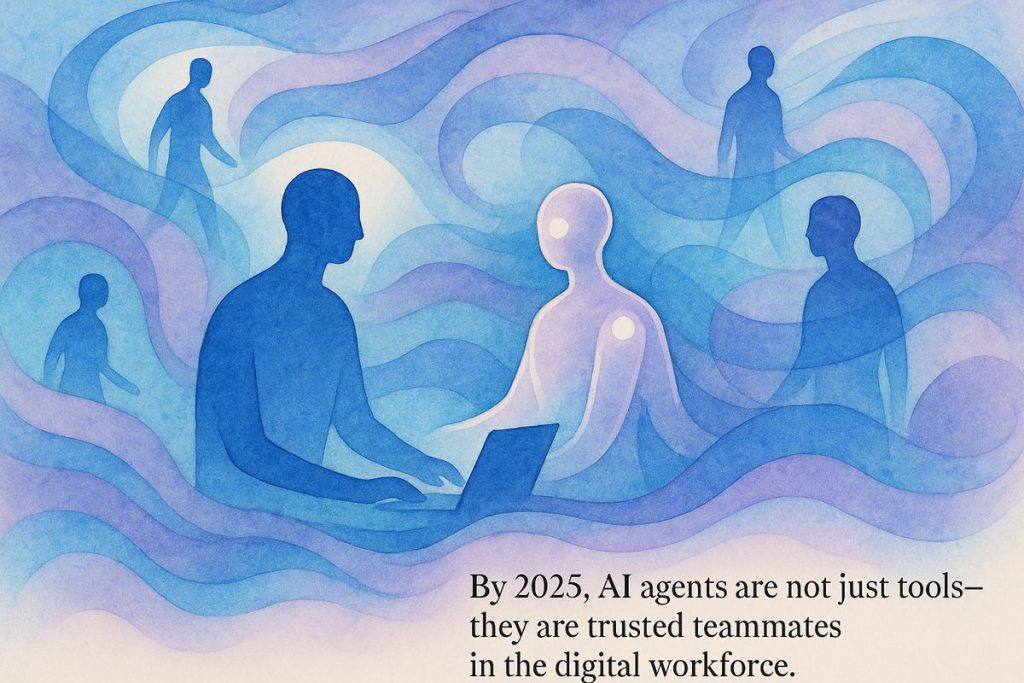By 2025, AI agents have become smart, digital colleagues in offices everywhere. These agents can jump between tasks and systems, freeing people from boring, repetitive work. They’re like fast-learning interns who never get tired and help humans focus on more important jobs. Security and management are essential as these agents blend into teams, sometimes even getting their own reviews. While some things are still uncertain, most people feel relieved to let the digital helpers take on the dull stuff.
What are AI agents and how are they transforming the digital workforce in 2025?
AI agents are advanced, context-aware digital colleagues that autonomously manage tasks across multiple systems—like CRM, customer support, and e-commerce. By 2025, they free humans from repetitive work, enable seamless automation, and require responsible deployment with robust security and effective management.
Dawn of a Strange New Colleague
It’s funny—one day you’re sipping burnt office coffee, the next you’re onboarding a digital agent who never sleeps, never whines, and (so far) hasn’t stolen your yogurt from the communal fridge. By 2025, this scenario isn’t sci-fi; it’s standard. Organizations from pharma behemoths like Roche to nimble fintech startups are discovering their payrolls now include not only people, but an always-on, hyperspectral breed of digital colleague: the AI agent. I don’t mean the old RPA bots that only followed strict workflows like a metronome. No, these are clever, context-savvy operators who can leap across systems—CRM, call center, e-commerce—with the grace of an Olympic gymnast.
I’ll admit, the first time I saw one wrangling multiple tickets in Zendesk while updating Salesforce, a shiver ran up my spine. Was it awe, or existential dread? (The answer, as usual, somewhere in between.)
From Automation to Autonomy: What Changed?
Let’s get concrete. Traditional automation—like the early days of RPA—was about rigid scripts: “If X, then Y.” No improvisation, no jazz. By contrast, today’s AI agents are more like polymathic interns: they learn, adapt to new data, and can even juggle tasks across platforms in real time. Just ask anyone who’s seen Cognigy or GetKnit agents at work (see here; or here). Remember that time your email rules melted down because of a rogue emoji? These agents would have sorted it, flagged the sender, and—if you let them—sent you a scented apology e-card. (Ok, that last bit is illustrative.)
Here’s where the palimpsest comes in: beneath each new layer of agent capability, you can trace the faded outlines of legacy scripts and manual workflows. The effect is unmistakable, like the distant hum of a mainframe beneath a symphony of live data feeds.
The Human Factor: Letting Go and Leveling Up
So what does this mean for actual humans? Well, for one, people are finally free of the drudgery that numbed them senseless—endless data entry, triaging support tickets, chasing signatures. Workday’s new Agent System of Record (ASOR) (source) makes it possible to manage AI agents just as you would their carbon-based teammates: onboarding, security permissions, even performance reviews (though, fair warning, agents don’t always take constructive criticism well).
I had to stop and ask myself: am I ready to coach a tireless digital entity that never gets Monday blues? Ugh. But soon enough, the relief of not answering the 4th password reset request by 10 a.m. every day made me a convert. There’s even a certain satisfaction in seeing agents seamlessly escalate tricky cases to humans, ensuring the customer journey’s velvet texture isn’t lost to algorithmic roughness.
Security, Taxonomy, and the Sound of Progress
Of course, the rise of digital agents hasn’t been all smooth. Responsible deployment, especially in regulated industries like life sciences, means robust access controls, secure API integrations, and a taxonomy that helps you pick the right agent for the right task (see PwC’s take; and Holmes in The Information). Holmes divides agents into seven fascinating types, each with their own quirks and strengths. The metaphor that springs to mind? It’s like assembling a jazz band—picking your virtuoso soloists and reliable rhythm section, one agent at a time.
And then there’s the sensory detail that sticks: that faint, electrical scent in the server room when your new workforce whirs to life at 3 a.m. while you’re at home, dreaming of a world where every spam call is quietly handled by your digital proxy. A sigh of relief, a little frisson of uncertainty—will they make us obsolete, or just very, very well-caffeinated?
Living With (and Learning From) Digital Storms
If you’re still worried about missing the memo, fear not: news sources like DIGITAL STORM weekly, with its 500,000 subscribers, will catch you up (link). Text or audio, your pick. These platforms are the collective campfire where stories, best practices, and the odd cautionary tale swirl together. One week, you’ll hear about a triumphant CRM integration (here’s a tutorial); the next, a spectacular failure no one wants to repeat.
In the end, the new digital workforce isn’t about wiping the slate clean. It’s the next line in the palimpsest, the low, steady drumbeat of progress. And if you ever find yourself missing the old monotony of copy-paste, I salute you. Stranger things have happened…
